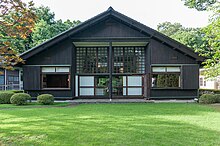Kunio Maekawa | |
|---|---|
 Maekawa House in the Edo-Tokyo Open Air Architectural Museum | |
| Born | 14 May 1905 Niigata, Niigata, Japan |
| Died | 26 June 1986 (aged 81) Toranomon, Minato, Tokyo, Japan |
| Nationality | Japanese |
| Alma mater | Tokyo Imperial University |
| Occupation | Architect |
| Practice | Mayekawa Kumio Associates |
| Buildings | The National Museum of Modern Art, Tokyo |
Kunio Maekawa (前川 國男, Maekawa Kunio, 14 May 1905 – 26 June 1986) was a Japanese architect and a key figure in Japanese postwar modernism. After early stints in the studios of Le Corbusier and Antonin Raymond, Maekawa began to articulate his own architectural language after establishing his own firm in 1935, maintaining a continuous tension between Japanese traditional design and European modernism throughout his career. Firmly insistent that both civic and vernacular architecture should be rendered through a modernist lens appropriate to the contemporary lifestyle of the Japanese people, Maekawa's early work and competition entries consistently pushed back against the dominant Imperial Crown Style. His postwar prefab housing projects borrowed from manufacturing strategies in the automotive industry to create houses that privileged light, ventilation, and openness against the feudal hierarchical principles perpetuated by the interior divisions found in traditional Japanese homes.[1]: 142
He is particularly known for his designs of the Tokyo Bunka Kaikan and the National Museum of Modern Art, Tokyo, as well as the Tokyo Kaijo Building, a 25-story tall skyscraper that became the flashpoint for the bikan ronso debates in 1970s Tokyo surrounding urban beautification and building height regulation. Many noted modernist architects began their careers in Maekawa's office, including Kenzō Tange and Miho Hamaguchi.[2][3]
His home (and one-time office), which he designed and completed in 1942, has been preserved and permanently installed in the Edo-Tokyo Open Air Architectural Museum.